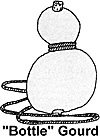As I found in the Southern Crimea in late summer of 1994, when water is so short it is actually non-existent, one has to pay particular attention to continuity of supply. In the heat (prolonged) of over 100 degrees, if you run out, you drop out. Tapping hitherto unused supplies also creates problems - we had the cholera and the dysentery to cope with.
How did our Ancestors do ?
They had the dysentery too, and the plague and a dozen other afflictions we’d probably have experienced if it were not for modern inoculations. The ubiquitous plastic bottle never left most people’s sides during filming. It wasn’t very robust, but it held liquid - that was what was important, a quick and easy-to-hand supply.
British troops in the Napoleonic period were equipped with the canteen, a three-pint capacity wooden barrel-type container suspended by a leather strap. Excellent reproductions of these are available today, sealed with a variety of unguents, from beeswax to paraffin wax, varnish or oils.
Some give a ‘taste’ to your water due to this. They all require regular maintenance - if they dry out, the wood shrinks and when you next fill it, it leaks. They are quite heavy when full, but they have the advantage of a robust construction. In the mud of Badajoz last year, I used mine as a seat to keep ‘my place of Honour’ dry. Filled with warm water, they make a good ‘hotty-botty’ on a freezing night. The strap comes in useful for dropping the canteen in water in a well or stream with steep banks.
 Available in the Peninsula was the container known as the ‘bottle gourd’. This curious appendage
to a creeper grows to a large size, and can be trained to form a bottle-type neck. Dried hard in the
sun, the skin sets, and you can bore a hole in it, remove the seeds, and you have with a cork
fitted a sizeable water bottle.
Available in the Peninsula was the container known as the ‘bottle gourd’. This curious appendage
to a creeper grows to a large size, and can be trained to form a bottle-type neck. Dried hard in the
sun, the skin sets, and you can bore a hole in it, remove the seeds, and you have with a cork
fitted a sizeable water bottle.
However, I found that when filled, the best size being around 1˝ pints, they can become quite fragile, especially around the hole, and also susceptible to being banged into things and pierced. Filling them is awkward too - their consistency just makes them want to float. Although featured in several illustrations of soldiers of the period, I would not recommend them as a ‘campaign item’, good as they look.
 Another Iberian theme is the leather ‘botella’. This goatskin pouch lined with tar is nipped together
at the neck to form a spout. Touristy ones have a spout fitted with a thread to remove a cap and
squirt wine into your mouth. A good size one, capacity two pints or so, will make a good period
container when the plastic top is completely removed and a wood or horn one fitted. Again, a cork
suffices as a seal. However, in very hot weather, the tar can melt and seal the spout, the wine can
taste sour, and the cork ‘weld’ itself in, and cover your finger tips with black gunge. However, they
do serve well (mine has lasted two years so far) - make sure you buy or acquire the proper article
and not a touristy copy, with the usual adornment of a bullfight or similar. These are made from
the wrong sort of leather and are lined with clear plastic.
Another Iberian theme is the leather ‘botella’. This goatskin pouch lined with tar is nipped together
at the neck to form a spout. Touristy ones have a spout fitted with a thread to remove a cap and
squirt wine into your mouth. A good size one, capacity two pints or so, will make a good period
container when the plastic top is completely removed and a wood or horn one fitted. Again, a cork
suffices as a seal. However, in very hot weather, the tar can melt and seal the spout, the wine can
taste sour, and the cork ‘weld’ itself in, and cover your finger tips with black gunge. However, they
do serve well (mine has lasted two years so far) - make sure you buy or acquire the proper article
and not a touristy copy, with the usual adornment of a bullfight or similar. These are made from
the wrong sort of leather and are lined with clear plastic.
Tin containers just go rusty, and I’ve never had one yet where the soldered seams didn’t split somewhere and leak. They also ‘clank’ noisily at your side.
Pet favourites such as pewter flasks or glass vessels make good little spirit flasks but are generally best kept in the knapsack. I have seen some canteens of the period made in glass, pewter (the pilgrim bottle for instance) but I think these by their very existence must be officers’ use as they certainly wouldn’t stand up to a hard campaign.
All these containers have their uses on campaign. The main point of a canteen is that you aren’t ‘tied’ to water - if you have a storage capacity for fluids, you can move on to another source. A tip from an old sage in the Crimea - in times of cholera, drink a bottle of dry white wine per day. One of the best keep-fit cures I ever heard of!
Back to Table of Contents -- First Empire #21
Back to First Empire List of Issues
Back to MagWeb Master Magazine List
© Copyright 1997 by First Empire.
This article appears in MagWeb (Magazine Web) on the Internet World Wide Web. Other military history articles and gaming articles are available at http://www.magweb.com